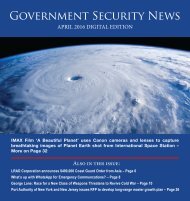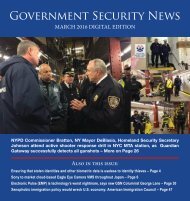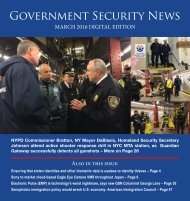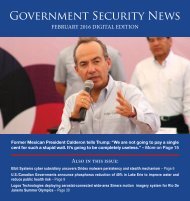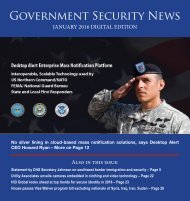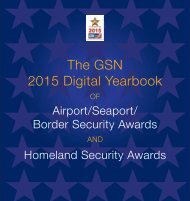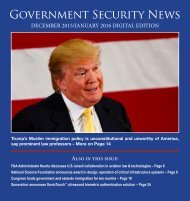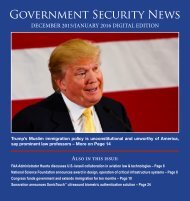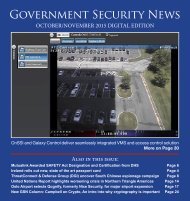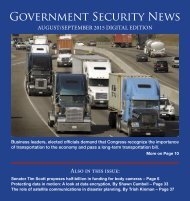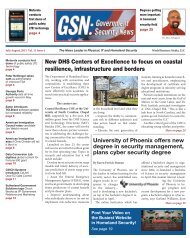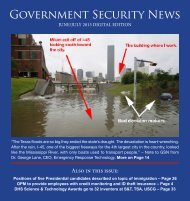The GSN 2015 Digital Yearbook
You also want an ePaper? Increase the reach of your titles
YUMPU automatically turns print PDFs into web optimized ePapers that Google loves.
ejected. If the application is approved, an attachment<br />
will be sent with the notification that must be shown on<br />
arrival. On arrival, the Immigration Workstation Application<br />
provides the immigration official with an extremely<br />
easy-to-use interface to process the traveler. <strong>The</strong> immigration<br />
official scans the barcode of the attachment,<br />
which is then sent to the server for validation. If successfully<br />
validated, the immigration official will continue the<br />
immigration process and begin to capture the traveler’s<br />
biometric information. <strong>The</strong> biometrics are stored with<br />
the traveler’s visa and immigration record and are validated<br />
when the travelers enter or leave the country. All<br />
of the traveler data and information collected is stored<br />
securely in Securiport’s IICS servers. Travelers who<br />
arrive to a country without a visa can utilize either the<br />
automated eVisa kiosks or the eVisa Application that is<br />
integrated with the Immigration Workstation Application<br />
to submit their information, biometrics and payment. All<br />
the information submitted is sent to the IICS and IIMS<br />
servers for validation and once complete, the approved<br />
visa is printed and the traveler is directed to immigration<br />
processing. eVisa applications can also be configured<br />
to be manually approved or rejected. Once the<br />
background validation has been completed, the application<br />
is ready for manual approval or rejection via the<br />
Visa Review Application. If approved, a notification is<br />
sent to the traveler with an attachment for them to provide<br />
on arrival. If the application is rejected, a notification<br />
is sent to the traveler informing them a visa cannot<br />
be issued and to contact the embassy or consulate for<br />
guidance. If more information is needed, a notification<br />
is sent to the traveler requesting them to update their<br />
application with the specific information needed.<br />
Section 4 – Strategic Benefits to Governments With an<br />
increase in the demand for international travel in our<br />
evolving global marketplace, it is necessary to have an<br />
efficient and effective system that simplifies the visa<br />
application process. Utilizing an eVisa system such as Securiport’s<br />
eVisa Management System, governments can<br />
prevent excessive hours waiting at visa desks, reduce<br />
the workload of staff working at airports, embassies and<br />
consulates, and provide easier facilitation for tourists<br />
and business travelers. By reducing the time and money<br />
it takes to apply for and issue visas, governments can<br />
only expect to see an increase in visa applications as<br />
well as the number of visitors, tourism and foreign trade<br />
revenue. Just recently, the Turkish government launched<br />
an e-Visa application system similar to Securiport’s eVisa<br />
Management System. Just weeks after implementing the<br />
e-Visa system, the Turkish government saw an increase<br />
in visa applications, going from a weekly average of 400<br />
applications to receiving more than 1,500 in just a few<br />
days [2] . <strong>The</strong> Turkish government hopes to develop and<br />
improve Turkey’s tourism and increase foreign trade<br />
with this eVisa reformation. By utilizing Securiport’s<br />
eVisa Management System that leverages their Integrated<br />
Immigration Control System (IICS) and Intelligent<br />
Information Management System (IIMS), governments<br />
and immigration officials can equip themselves with<br />
the actionable data and information needed to confirm<br />
a traveler’s identity at ports of entry and exit as well<br />
as at each stage of the immigration process. And with<br />
dynamic configurations, government officials can issue<br />
and manage any number of visa types required by their<br />
country.<br />
Section 5 – Summary and Conclusion Governments can<br />
derive great benefit from updating visa and immigration<br />
processes to leverage new technology that provides<br />
enhanced security and improved efficiency. Currently,<br />
the visa application process takes time, money and<br />
a high workload of the staff at airports, immigration<br />
checkpoints, embassies and consulates. Additionally, the<br />
time constraints of the current application process create<br />
multiple challenges and roadblocks for travelers who<br />
Continued on next page<br />
19



